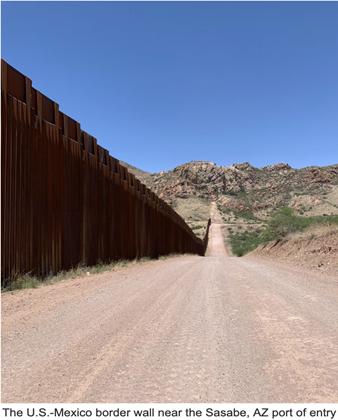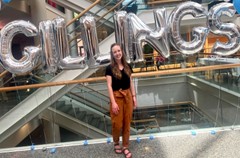Hello! My name is Quintin Van Dyk and I am an MPH student in the Global Health concentration at UNC Gillings. I grew up in Northern Arizona and completed my bachelor’s degree at Lewis & Clark College, where I studied biology. One of my main interests within public health is at the intersection between migration and health. This interest is in large part motivated by my upbringing in Arizona, where I saw firsthand how migrants in my community encountered barriers to accessing health services and experienced lower quality healthcare than the general population. As I continue studying public health at UNC, I hope to further develop my understanding of migrant health and the barriers facing migrant populations in our country.

A few weeks ago, I returned to my home state where I am currently completing my MPH practicum by working with Casa Alitas in Tucson, AZ. Casa Alitas is a humanitarian aid organization dedicated to supporting and providing shelter to migrants and asylum seekers. The organization has a network of shelters and hotel spaces in the Tucson area where people can come after they have been processed and released by U.S. Customs and Border Protection (CBP). Casa Alitas’ mission is to prevent street releases of asylum seekers by CBP, something that has been a huge problem in other U.S. border communities like El Paso, TX.
In the two-and-a-half weeks that I have spent here so far, I have already learned a lot. I have been splitting my time between an ongoing research project and working on the floor in the shelters to help provide the guests with food, clothing, and to assist them with their travel arrangements. I have met people from all around the world, including folks from Mauritania, India, Brazil, Colombia, Nicaragua, Guatemala, Mexico, Ecuador, Bangladesh, and many more countries. I have unfortunately heard many sad stories of family separation and violence that our guests have experienced during their arduous journeys through the Sonoran Desert. I have also learned more about the different global factors that force people to migrate, from climate change to political unrest and violence.
Last week, I was fortunate to have the opportunity to participate in a migrant health service-learning trip that was organized by the UNC School of Medicine. I joined a group of 12 people including medical students, public health students, medical residents, and a Family  Medicine physician. Together, we volunteered at Casa Alitas on projects including creating art and decorations for the newest shelter, hanging clotheslines for the guests to dry their clothes, and creating a medication catalog for the medical staff. We also volunteered with other local humanitarian aid organizations including Tucson Samaritans, Green Valley Samaritans, and Humane Borders. With these organizations, we went on trips into the desert to see the border wall, check on water-drop tanks, pick up trash and left behind migrant belongings, and offer food and water to anyone that we encountered in the desert.
Medicine physician. Together, we volunteered at Casa Alitas on projects including creating art and decorations for the newest shelter, hanging clotheslines for the guests to dry their clothes, and creating a medication catalog for the medical staff. We also volunteered with other local humanitarian aid organizations including Tucson Samaritans, Green Valley Samaritans, and Humane Borders. With these organizations, we went on trips into the desert to see the border wall, check on water-drop tanks, pick up trash and left behind migrant belongings, and offer food and water to anyone that we encountered in the desert.
Seeing the border wall in person was an intense and impactful experience, not just because of its size but because of what it represents. The wall is about 30 feet tall and stretches across 190 miles of the Arizona-Mexico border. I was struck by the contrast between the beauty of the Sonoran Desert and the inelegance of the border wall built on top of it. The wall has created a lot of trash and discarded pieces of steel that lie cast into the sand on the American side. It is a manifestation of American immigration policies, which have evolved to make crossing the border increasingly difficult and dangerous for people across the globe, especially those coming from countries like Cuba, Venezuela, Nicaragua, and Haiti. The woman who led our trip to the border wall had a powerful quote that resonated with me, describing the wall as “a scar on the environment and a scar on us as people”.
Overall, I am really enjoying living in Tucson so far and am thankful for the opportunity to work with Casa Alitas. I have already become fond of the amazing Mexican food, endless hiking trails, and incredible sunsets that make southern Arizona famous. Moving forward, I will be spending more time working on a research project to better understand the impact of immigration policies like Title 42 on migrants and asylum seekers attempting to cross the border. Thank you for reading my blog!

– Quintin


